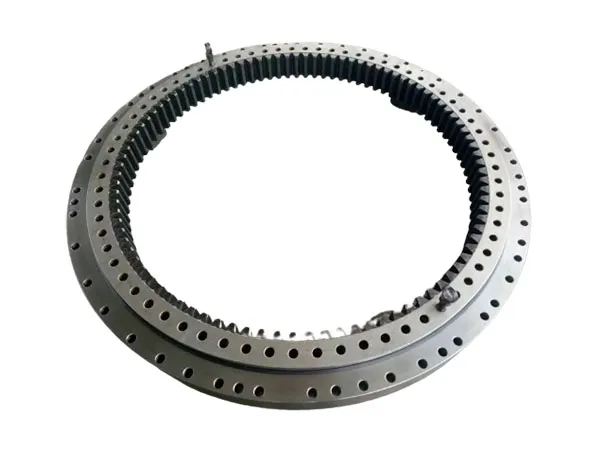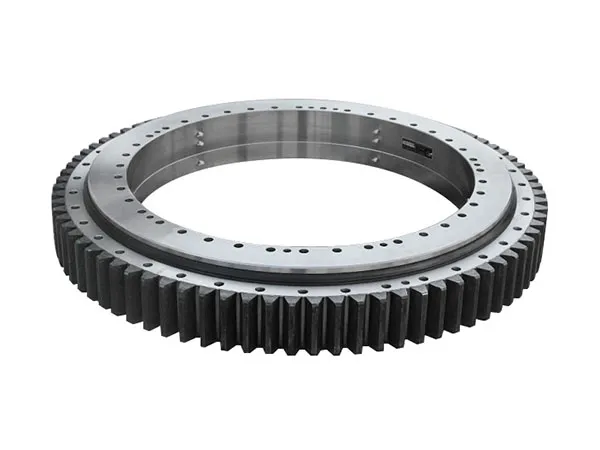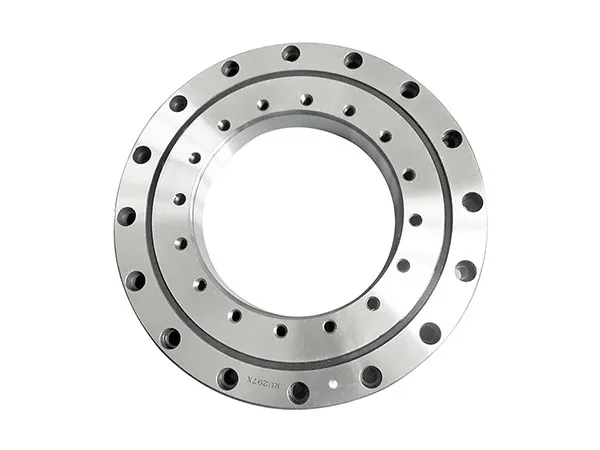- +86 13837949030 +86 15890619536
- info@lymcbearings.com export@lymcbearings.com
- Luoxin Industrial Cluster, Luoyang City,Henan Province,China
Time:2025-07-28 02:42:32 Source:LYMC Slewing Bearing
Abnormal noise in a double-row ball slewing bearing can indicate a range of issues, from minor lubrication problems to significant component damage. Addressing the noise promptly is crucial to prevent further damage and ensure the longevity of the bearing and the machinery it supports.

Here are the common methods to solve abnormal noise in double-row ball slewing bearings, categorized by their underlying causes.
Insufficient Lubrication: This is one of the most common causes.
Solution: Regularly add the appropriate type and amount of grease. Follow the manufacturer's recommended lubrication schedule. If the bearing has been dry for a while, it may require more frequent lubrication initially.
Poor Quality or Aged Grease: Grease can degrade over time, losing its lubricating properties.
Solution: Clean out the old, contaminated, or degraded grease and replace it with fresh, high-quality lubricant suitable for the bearing's operating conditions (temperature, load, speed).
Uneven Grease Filling: Inadequate or uneven distribution of grease can lead to localized friction and noise.
Solution: Ensure the grease is evenly distributed throughout the raceway during lubrication. Running the bearing for a few rotations after greasing can help with distribution.
Foreign Particles: Dirt, dust, metal shavings, or other debris entering the bearing can cause friction, wear, and noise. This often results in a "dust sounding" or "rattling" noise.
Solution: Disassemble the bearing (if feasible and necessary), thoroughly clean the raceway and rolling elements, and remove all foreign matter.
Prevention: Improve sealing arrangements to prevent contaminant ingress. Regularly clean the surrounding area of the bearing.
Uneven Installation Surface: If the mounting surface of the slewing bearing is not flat, it can lead to uneven loading, deformation of the raceway, and abnormal noise.
Solution: Re-process or ensure the flatness of the mounting surface. If necessary, use shims or gaskets to compensate for unevenness and ensure proper seating of the bearing.
Loose Mounting Bolts: Loose bolts allow the bearing to flex or deform, leading to uneven contact and noise.
Solution: Re-tighten all mounting bolts to the manufacturer's specified torque using a torque wrench, following the recommended tightening sequence (e.g., diagonal principle).
Misalignment: Misalignment of bearing components or the connected machinery can cause uneven loading and excessive wear.
Solution: Verify that all bearing components and associated shafts/structures are properly aligned. Adjust as needed.
Improper Preload: Incorrect preload during installation can also contribute to noise.
Solution: Ensure the bearing is installed with the correct preload according to the manufacturer's specifications.

Worn or Damaged Raceways/Rolling Elements: Over time, the raceways or balls can suffer from wear, pitting, flaking, brinelling (indentations), or cracking, leading to periodic or continuous noise.
Solution: If the wear or damage is significant, the slewing bearing may need to be replaced. Minor surface roughness might be managed through proper lubrication, but severe damage requires replacement.
Damaged or Worn Seals: Compromised seals can lead to grease leakage and allow contaminants to enter the bearing.
Solution: Inspect and replace damaged or worn sealing strips.
Defective Components (Manufacturing Defects): In some cases, abnormal noise can be attributed to manufacturing defects such as surface roughness, roundness errors, or internal flaws.
Solution: If a new bearing exhibits persistent abnormal noise despite proper installation and lubrication, contact the supplier for inspection and potential replacement. High-quality bearings from reputable manufacturers are crucial.
Overloading: Exceeding the bearing's load capacity can accelerate wear and generate noise.
Solution: Monitor and manage the applied load to ensure it stays within the bearing's design limits. If the equipment is consistently overloaded, consider a bearing with a higher load capacity or redesign the system.
Excessive Vibration: External vibrations from the machinery can be transmitted to the bearing, causing noise.
Solution: Identify and address the source of external vibration. This might involve balancing rotating components, reinforcing the machine structure, or using damping materials.
Harsh Environment: Operating in high temperatures, dusty, or moist environments can accelerate bearing degradation.
Solution: Implement protective measures like improved sealing, specialized lubricants, or bearings made of corrosion-resistant materials for harsh environments.

Regular Inspections: Periodically inspect the bearing for visual signs of wear, damage, loose bolts, and proper lubrication.
Vibration and Acoustic Monitoring: Use vibration sensors and acoustic analysis to detect early signs of bearing issues before they escalate into significant problems and loud noise.
Predictive Maintenance: Implement predictive maintenance techniques to monitor bearing health and schedule interventions proactively.
Proper Training: Ensure personnel involved in installation, operation, and maintenance are properly trained in bearing handling, installation, lubrication, and troubleshooting.
Diagnose the Source: First, confirm the noise is indeed coming from the slewing bearing and not other parts of the machinery.
Check Lubrication: This is the easiest and often most effective first step. Add grease and observe if the noise reduces.
Inspect for Contamination: Look for visible signs of dirt or debris around the seals or in purged grease.
Check Mounting Bolts: Systematically check and tighten all mounting bolts to the specified torque.
Assess Installation Flatness: If the noise persists, consider checking the flatness of the mounting surface.
Evaluate for Wear/Damage: If the above steps don't resolve the issue, the bearing components may be worn or damaged, requiring a more in-depth inspection or replacement.
By systematically addressing these potential causes, you can effectively diagnose and solve abnormal noise issues in double-row ball slewing bearings, ensuring optimal performance and extending their service life.